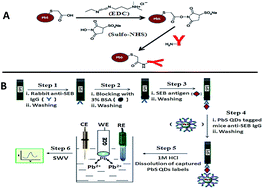Sensitive detection of staphylococcal enterotoxin B (SEB) using quantum dots by various methods with special emphasis on an electrochemical immunoassay approach†
Abstract
Staphylococcal enterotoxin B (SEB) is a potent foodborne pathogen and categorized as a class B type of biological warfare agent. In this research work, SEB is detected by various sensitive analytical methods such as enzyme linked immunosorbent assay (ELISA), quantum dots-based fluorescence linked immunosorbent assay (QDs-FLISA) and square-wave voltammetry (SWV). The obtained results were compared in terms of sensitivity, ease of experimentation and analysis time. For the QD-based detection, fluorescent lead sulfide (PbS) QDs were prepared by a bottom-up approach and characterized by various techniques. Highly specific antibodies against SEB were conjugated with the prepared PbS QDs and were used as revealing antibodies. For the electrochemical detection of SEB, rabbit anti-SEB polyclonal antibodies (primary antibodies) were immobilized on screen-printed electrodes (SPEs) followed by the addition of various concentrations of SEB antigen. These electrodes were further incubated with revealing antibodies. Finally, 1 M HCl solution was added to the SPE to dissolve the PbS QDs which were captured in a sandwiched immunoassay, and resulting Pb2+ ions were determined by the SWV method using a glassy-carbon electrode. The obtained peak current is proportional to the amount of Pb2+ ions which indirectly depends on the SEB concentration. Linearity was observed in the concentration range of 1 ng mL−1 to 1 μg mL−1 of SEB antigen. The limit of detection was found to be 0.01 ng mL−1 for SEB. The results reveal that electrochemical SWV sensing is much easier, faster and provides high sensitivity as compared to the other methods. It is found that the detection limits achieved for sandwich ELISA and QDs-FLISA were 0.24 ng mL−1 and 0.03 ng mL−1 respectively. In addition, the developed SWV method can be implemented for the on-site detection of SEB particularly for civil and defense applications where security is of prime importance.


 Please wait while we load your content...
Please wait while we load your content...